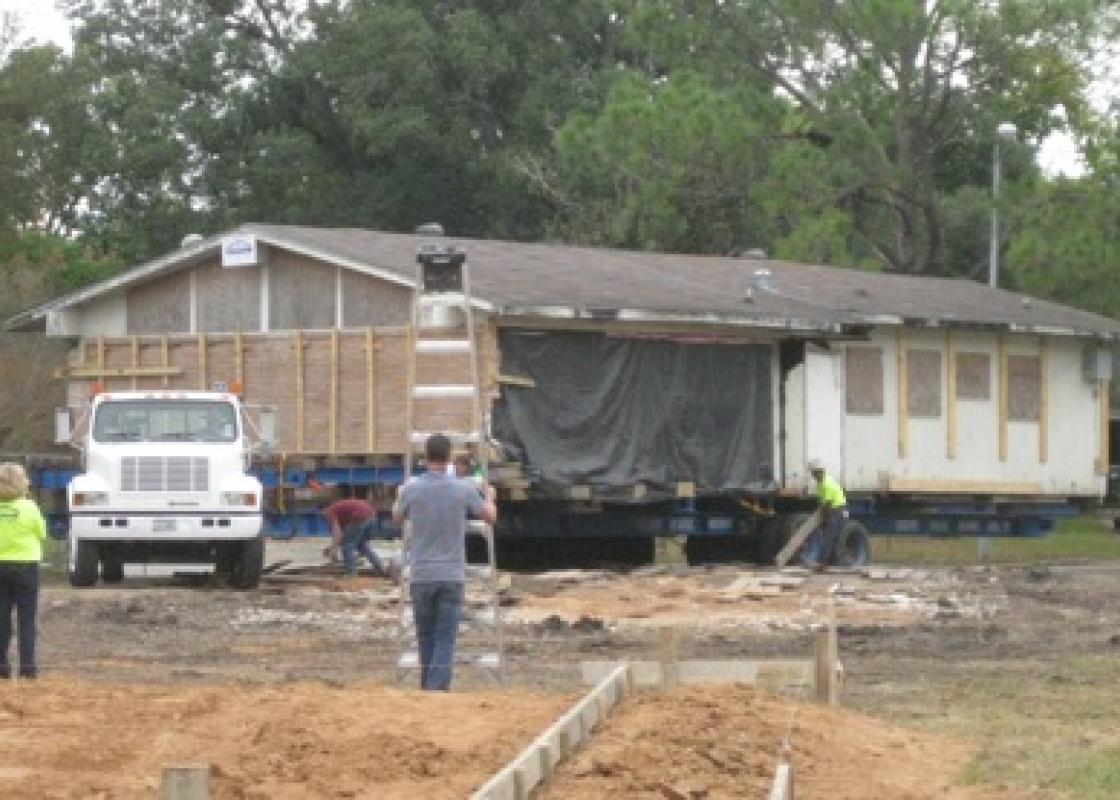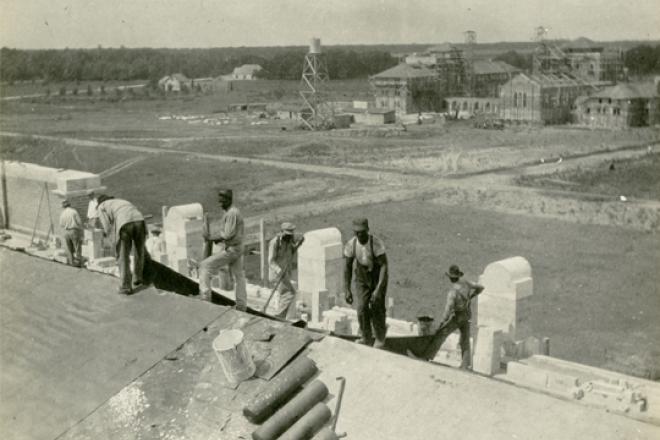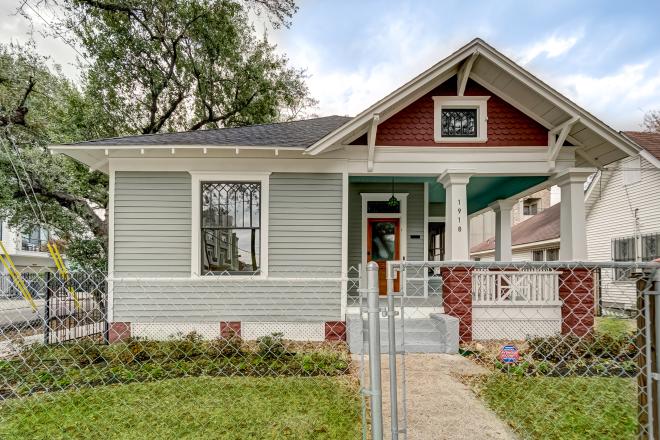
Spectators watch as the rotation of a house in Sharpstown is completed.
It is 11 a.m. on a Thursday in Sharpstown, Houston. Roughly forty spectators sit obediently on metal benches provided by Cherry House Moving Company — a mix of Rice University students, architects, “just in for the day” New York art scenesters and garden-variety devotees of conceptual artist Mary Ellen Carroll. Today, Carroll will rotate the ranch home at 6513 Sharpview as the climactic moment in her decade-in-the-making work, “Prototype 180.”
Arguably the most pivotal moment in the artist’s career, “Prototype 180” proposes a myriad of questions on art, architecture, and urbanism. Most obvious is that Carroll is intervening in the makeup of this neighborhood, thereby underscoring the historic significance of Sharpstown as the nation’s largest community of single-family homes when it was conceived in 1954, and its transformation after the 1982 economic downturn from white suburb to immigrant-rich density. The rotational rupture also questions issues of land art and real estate, policy and public space, urban sprawl and first-ring suburbs.

The multilayered aspect of this conceptual work has drawn today’s audience, which is just as much a part of the artwork as the moving truck and clay soil that will buttress the new cement foundation. Yet an air of mystery of precisely what “Prototype 180” implies, and what its result will be, permeates the humid air. It is intrigue rather than answers that lures the spectators; despite years of dialogue, everyone remains poised at the edge of understanding.
Bewilderment with Carroll’s work has overcome even art world insiders, notably MoMA’s Barry Bergdoll, and most recently Joyce Wadler of the New York Times (a publication for which Carroll herself has written). In an interview with the artist, published on Oct. 17, Carroll consistently corrects Wadler for not asking the “right” questions, as the journalist focuses on the project’s budget, its funding, and the impact on neighborhood property values. Instead, the artist emphasizes that “Prototype 180” comments on the culture of Houston by imbuing the home with its own autonomy, becoming a free enterprise in itself. Ultimately, Wadler’s most cutting question is what qualifies “Prototype 180” as a work of art. (The simple answer being that Carroll is making readymade architecture “performative.”)
As a conceptual artist, Carroll has no obligation to explain her work. She states in her 2008 monograph, “ … why can’t people take a responsibility to make their own decisions about what they are looking at, the pleasure they derive from it, and what they are seeing instead of being told the supposedly correct interpretation?”
In her presentation to her audience on Thursday immediately before the rotation, Carroll reveals herself as not the cocky outsider artist critiquing the Houston model, but instead somewhat modest, thanking the 2,438 people directly engaged with “Prototype 180,” especially the moving company and the attorney who ironed out any issue with the city. Carroll reveals the degree of thought that went into her project: she’s been researching Sharpstown for over 20 years, wrestling with the implications of the first-ring suburb.
It is no secret that a mountain of complications have arisen in realizing “Prototype 180” — the project was routinely delayed because of the contractual and structural issues that accompany an architectural intervention. Thursday’s event is interrupted by bouts of rain, and the moving truck’s wheels temporarily become entrenched in muddy clay. But Carroll eschews ego and embraces the faults that come with performance — she even entitles a chapter “Mistakes” in her monograph, where she recounts unwittingly performing a work in Puerto Rican-dialect Spanish in Argentina.
By 2:30 p.m., with the aid of a lime powder and wooden planks, Carroll has triumphed. The house has been rotated.
The narrative of “Prototype 180” is not even half complete. The house, although successfully rotated, still stands elevated on the Cherry House Moving truck. A new slab will be paved, and once the home finds its new resting place, Carroll will rehabilitate the building, which was left uninhabited for 13 years. This process includes installing “PIGRO,” plumbing art designed by Carroll while in residency at the Kohler Company in 2007, as well as vertical farming and solar paneling. Architect Charles Renfro, a close friend and collaborator of Carroll’s, said:
The house will be repurposed as a new kind of community center, one founded on ideas and debate. It will become a laboratory for new ways of thinking about making sustainable architecture, not simply by reducing its carbon footprint, but also by rethinking our first-ring suburbs and creating a model of how to keep these neighborhoods vital and sustainable. It will become a site of conversation about architecture and the objects that occupy it. It will also be a local hero, sharing with its neighbors technology that will help lower costs and raise the standard of living to all of the neighborhood.
Renfro’s statement suggests that “Prototype 180” may bring to Sharpstown an approach similar to that of Project Row Houses’ in the Third Ward. If so, Carroll’s elusive language of history and theory will be grounded in the push for sustainability. Renfro’s description of community service, however, remains distant from today’s performance.

Charles Renfro and Mary Ellen Carroll
It is just past 2:30 p.m. now, and with the house fully rotated, only a handful of spectators remain, including Renfro, artist Molly Gochman (who will create a landscape artwork onsite), and the diehard Mary Ellen Carrollphiles that have taken off work or flown in to see the rotation. Champagne bottles pop as the artist distributes roses to the cast of construction workers who have toiled on the property for months. It is not clear to me whether the group is rejoicing in awe of the artwork, or simply celebrating that the rotation is complete. The mood is more akin to a graduation ceremony than an avant-garde “happening.”
The elephant in the room (or shall we say “Subdivision 1”) remains that not everyone is privy to what “Prototype 180” means, from Carroll’s collaborators to Sharpstown residents. When asked on Thursday afternoon how she feels about the rotation’s realization, Carroll replies, “I’m still trying to wrap my head around it.”
And so the artist reveals that she does not exist on a higher intellectual plane from her audience. Rather than an answer, “Prototype 180” is another question, one that is just as intriguing and frustrating as the Houston culture it so obsequiously comments upon. Mary Ellen Carroll’s pièce de résistance represents inconclusiveness.
Related Articles:
In Texas, an Artist Plans to Rotate a House 180 Degrees [NY Times]
No ordinary house flipper: Mary Ellen Carroll to turn art around [CultureMap]
The original post incorrectly stated that the 6513 Sharpview property would be annexed by the neighboring Bayland Park. We regret this error.










